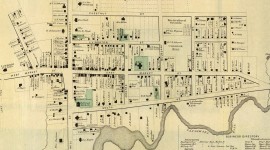Landscape Information
Tucked behind a residential neighborhood, this property incorporates 44 acres east of the Hudson River and features a reconstructed Colonial fieldstone house and garden, set atop a sloping lawn. The lawn, which is bordered by wooded lots to the north and south, offers borrowed western views of the river and opposite shore. The original house, built by Samuel Verplanck (circa 1730), served as the Continental Army headquarters of General Friedrich von Steuben during the Revolutionary War. In 1783 patriot officers gathered at von Steuben’s headquarters and founded the Society of the Cincinnati.
In 1804 Daniel Crommelin Verplanck and his daughter Mary Anna established a garden on relatively level lawn south of the house. The garden was managed from 1828 to 1866 by master gardener James Brown, who was born into slavery in Maryland and later manumitted by the Verplancks. Beginning in 1880, the garden was maintained by Virginia Eliza Verplanck. A peony border marked the northern edge of the four-acre, rectilinear garden, which was aligned with the south façade of the house. Formal beds of ornamental flowers flanked the garden’s northeast entrance, with a modest pear orchard west of the entrance screening the garden beyond from view. Rows of beds planted with vegetables and fruits were separated by gridded, axial grass and gravel paths, with a pergola shading the path that led to the largest bed at the garden’s rear.
The house burned in 1931 and was reconstructed in 1975. Beginning in 1995 the garden was rehabilitated and now includes formal beds configured according to a plan provided by Virginia Eliza Verplanck in her 1913 publication, Every Day in My Garden. Plant materials include boxwoods, ornamental grasses, as well as reintroduced yuccas, roses, and peonies propagated from extant specimens. Mount Gulian was listed in the National Register of Historic Places in 1982.






